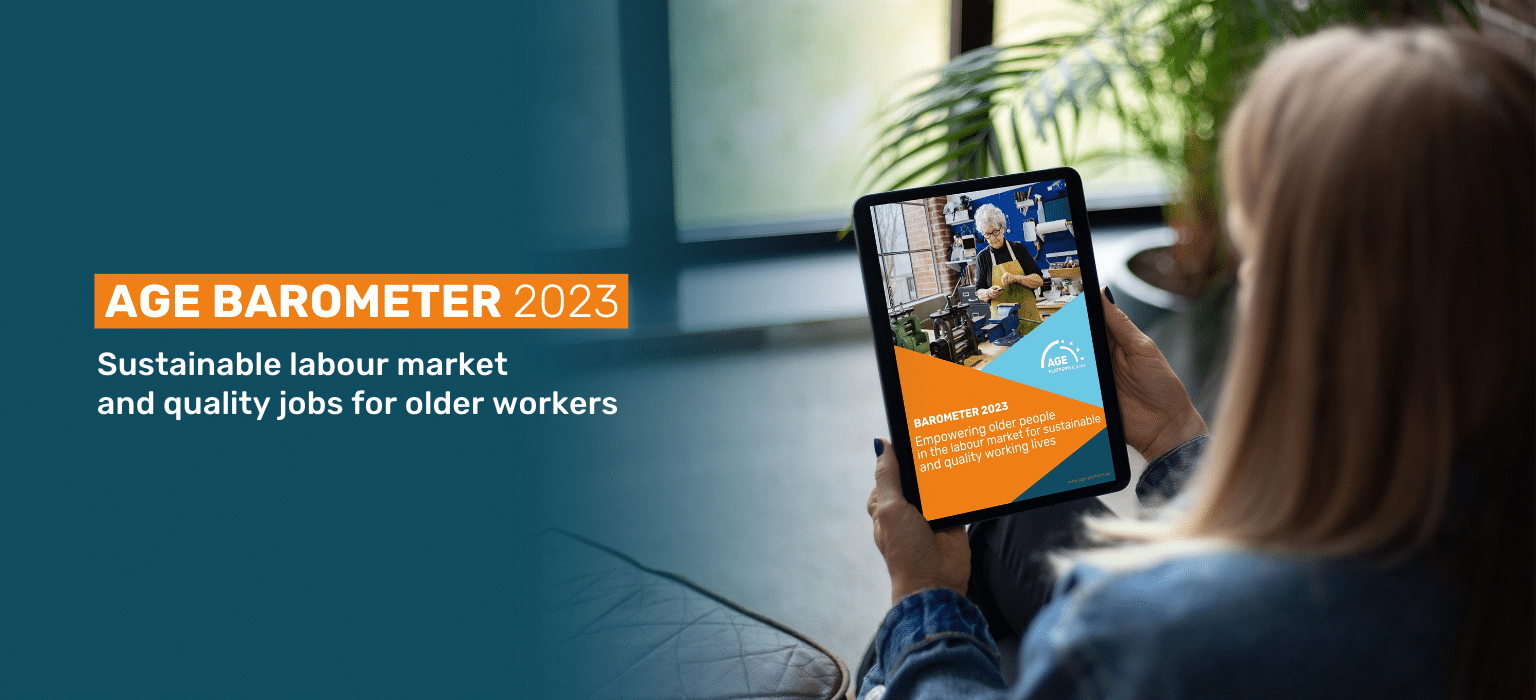France
Information provided by the coordination AGE France and desk research

Support in the labour market
The employment rate of older persons remains above the European average until the age of 59 and then falls below the European average. The French approach to ageing in the labour market includes some good practices that are foreseen in theory but do not seem to be systematically implemented in practice.
Several tools exist to facilitate professional reconversion. One of these is the Validation of Acquired Experience (VAE), which makes it possible to obtain a diploma, title or certificate of professional qualification on the basis of the main activities that a worker carries out or has carried out, the context in which they are carried out and the resources mobilised. It offers the possibility of reorienting oneself by applying sectors for which it is considered that the demand for employment is or will be exponential. Similarly, the Professional Training Account (PTA) accessible to all working adults aged 16 and over was presented in the Lifelong Learning Barometer 2021. Training accounts allow individuals to use their accumulated training rights to undertake training or skills assessments from a list of certified opportunities, recognised by the State. However, the fact that this system is free of charge is challenged by the intention to introduce a co-payment, which will particularly affect the most vulnerable employees.
An interesting initiative for the long-term unemployed, including the very old, is the “Territoires zéro chômeur de longue durée“ (TZCLD) experiment set up following the law of 29 February 2016. It was initially rolled out in 2017 in ten pilot areas and will be extended to other areas in 2021. This experiment enables the socio-professional integration of people who are permanently unemployed (PPDE) who so wish. The project is based on three principles: that no one is unemployable, that employment must be adapted to each individual, that there is no shortage of job opportunities, and that money is no barrier. On this last point, the initiative notes that joblessness imposes numerous costs on society, as well as a loss of income (taxes, social security contributions) and induced costs linked to the social consequences of unemployment. The aim of this initiative is to reallocate these costs to financing jobs for all those affected, without any additional costs to the community. The results of the first experiment show the positive effect of this initiative on the beneficiaries: “in the absence of this scheme, only 55.9% of EBE employees would have been in employment, and just over a third on permanent contracts”.
The last campaign on the employment of older people dates from 2012-2013 with the “Contrat Génération”. The lack of follow-up of these campaigns and public policies prevents the full use or improvement of existing tools such as those mentioned above and recruitment aids for older job seekers. However, recruitment difficulties and the recent debates on pension reform have brought back to the forefront the issue of older people’s employment. An interesting tool called the “index senior” is currently discussed with the aim to promote transparency on the number of older employees and make companies more responsible for maintaining and improving the employment of older workers. In particular, such a tool would make it possible to effectively measure the efforts and progress made by companies in employing older people.
Some pension funds offer retirement preparation courses such as the Caisse Nationale d’Assurance Vieillesse, a French social security body that manages the minimum pension for private sector employees, self-employed workers, public sector contract workers and artists, as well as the supplementary pension for self-employed workers. It has an extensive local network of 220 agencies and 286 reception points for pension beneficiaries and is present in many public service centres. It offers a number of tools, including online tools, to help prepare for retirement. There is, for instance, “Mon agenda retraite” which provides regular information and personalised advice on how to prepare for retirement with peace of mind. There is also a podcast entitled “Le temps d’être soi”, which deals with a number of subjects such as the break with working life and calls for people to prepare for retirement, to get used to a new status, a new rhythm and possibly to continue an activity through association work, for example.
Statement of commitment on the place of employees over 50 in the company
Communicate the commitments of this act to all employees and to the management line. Raise awareness of the importance of living well together, the strength of intergenerational relations and the fight against age-related stereotypes in line with the company’s values.
To act with kindness and respect towards all our employees, throughout their professional careers, whatever their age.
Support the development of skills and encourage employees to engage in actions to develop their employability and to open up new career opportunities.
Recruit people at all stages of their careers, offering opportunities throughout their working life to enable everyone to work in an inclusive environment until retirement.
Encourage the transmission of knowledge and the sharing of experience between generations by putting in place dedicated mechanisms.
Valuing experienced employees, highlighting inspiring career paths and role models to change the perception of ageism.
Offer adapted and individualised support on aspects of health and well-being at work throughout the career (notably related to menopause or andropause, for instance).
Accompany and support employees who are caregivers.
Pay particular attention to preparing and supporting employees when they retire (transitional arrangements). At the time of departure, thank employees by celebrating and acknowledging their careers.
After departure, for those who wish to do so, the company can offer to maintain the link, in particular through the Alumni, or to encourage an associative commitment.
The Club Landoy, a think tank dedicated to the demographic revolution, has produced a Commitment Act on the place of employees over 50 in companies, which 32 companies have signed. By signing this act, the employers commit to deepen their work on this subject by upgrading existing measures or developing new ones. In a process of co-construction and exchange, they share good practices and meet annually to communicate the progress of their actions.
Age discrimination in employment
In France, the Defender of Rights has been responsible since 2011 for defending people whose rights are not respected and ensuring equal access to rights for all. Its role is to investigate age discrimination, among other grounds of discrimination, but he did not work with AGE members on a specific case. Among its tasks, it is in direct contact with professional actors such as Pole Emploi, the French public employment service, and with the Defender of Rights within the Liaison Committee of Employment Intermediaries. Launched in September 2012, the Liaison Committee meets to discuss anti-discrimination and equal treatment policies in recruitment. In particular, the members of the Committee exchange information on difficulties and good practices and follow up on the Charter Together for Equality in Recruitment, signed on 7 October 2013. No specific cases have been made public yet.
The specific situation of older women in the French labour market is not particularly targeted, but in general, in order to encourage employers to end employment inequalities, companies with at least 50 employees are required to publish a gender equality index. The publication of this index encourages companies to reflect on the careers of women compared to men, but there is no obligation on employers to improve the number of women employed. Support to address the inequalities faced by older women at work is needed.
In 2019, the National Association of Human Resources Directors (ANDRH) proposed a “senior index” modelled on the gender equality index, to encourage “the hiring and retention of older workers”. Like the gender equality index, this proposed index should be more than a simple incentive and should lead to an obligation of age equality and job retention policy for older workers. No legal action has been taken so far on this interesting proposal.
The Diversity Charter, a text of commitment proposed for signature by any employer who wishes, through a proactive approach, to act in favour of diversity and thus go beyond the legal and judicial framework of the fight against discrimination, aims to promote age equality and diversity in companies. This charter provides in particular for “the promotion of the application of the principle of non-discrimination in all its forms in all acts of management and decision-making of the company or organisation, and in particular in all stages of human resources management”, but also “the promotion of the representation of the diversity of French society in all its differences and richness, the cultural, ethnic and social components, within the workforce and at all levels of responsibility”.
Workplaces for all ages
Occupational medicine is an important element in France, but general measures concerning older workers are rare and often at the discretion of employers. Among the existing measures, since 2021, there is the mid-career medical examination which is an obligation when the employee reaches the age of 45. The purpose of this examination is to assess the adaptation of the workstation to the employee’s state of health. It takes into account the risks to which the employee is exposed, assesses the risks of professional disintegration and addresses ageing at work and the prevention of professional risks. After discussion with the employer and the employee, the occupational physician may propose adjustments to the workstation and/or working hours.
Finally, the French pension system takes into account the hardship of work, thanks to the Compte professionnel de prévention (C2P). This account allows a worker exposed to factors related to the rhythm of work, such as night work or repetitive work at a high frequency and under constrained pace, or factors related to an aggressive physical environment, such as exposure to noise or extreme temperatures, to accumulate points in a personal account. These points can be used by the employee in three ways: to access training for jobs that are less or not exposed to occupational risk factors, to benefit from part-time work without loss of salary, to validate quarters of increased old-age insurance duration and to allow for earlier retirement. Unfortunately, these points can only be used until retirement, although training to continue working after retirement could benefit both the retired person and the labour market as a whole.
This country assessment is part of the 2023 edition of AGE Barometer dedicated to employment, which you can download below. Find out more online here.
COUNTRY ANALYSIS
Contact

Sarah Loriato
Policy Officer on Employment and European Parliament Liaison
Sarah is in charge of AGE’s policy activities in the fields of employment, participation and active citizenship in old age. She also monitors EU initiatives on volunteering for older people and lifelong learning. She is responsible for the Task Force dedicated to on Employment, participation and active citizenship. Sarah also coordinates AGE’s relations with the European Parliament (EP).



